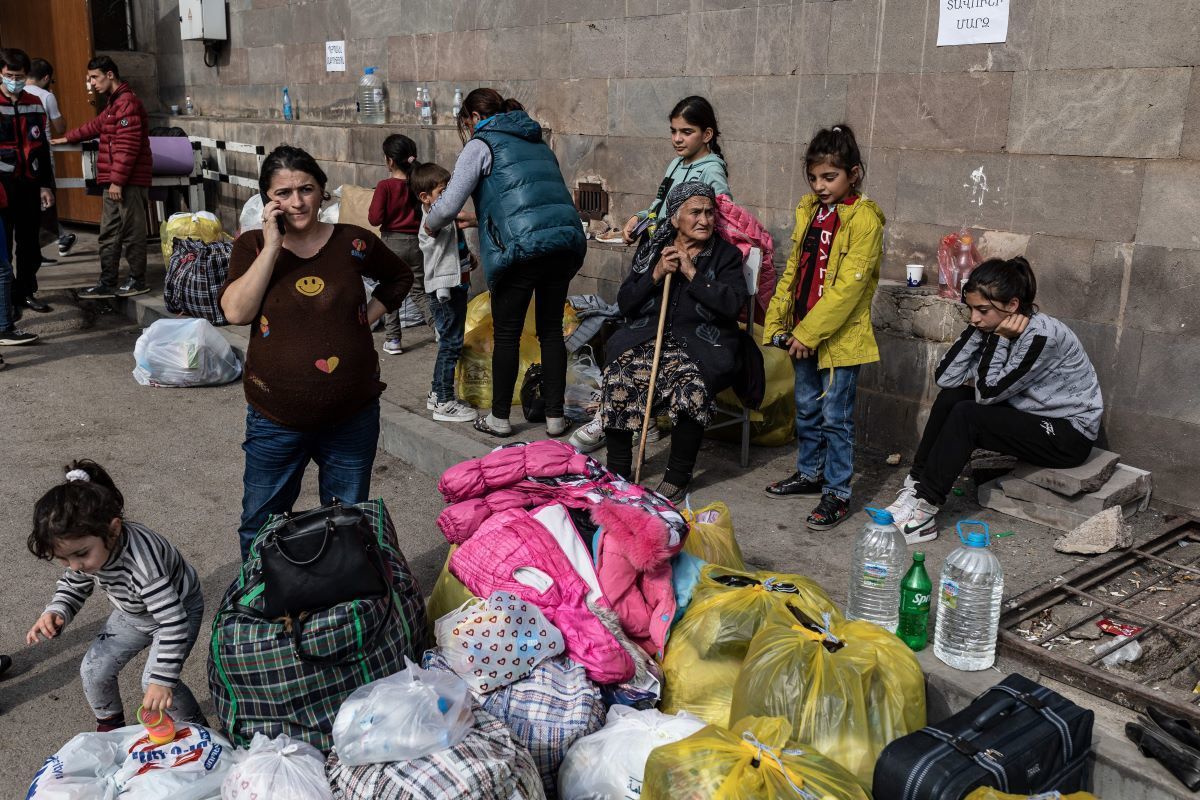**Ethnic Cleansing Survivors Feel Left Behind in Armenian Peace Deal**
*YEREVAN, Armenia* — Born and raised in her ancient Christian homeland of Artsakh (known internationally as Nagorno-Karabakh), 34-year-old legal professional and human rights advocate Marina Simonyan has spent her entire life under the shadow of violence and conflict, living through three different wars.
Like many from the Republic of Artsakh, a predominantly Armenian autonomous region within the internationally recognized borders of Muslim-majority Azerbaijan, speaking about the horrors of what happened leading up to and during the September 2023 invasion by Azerbaijan that forced over 120,000 people to flee is not easy. But these are stories that Simonyan feels the world must hear as her people struggle to start new lives as refugees in Armenia proper.
“I was born in the 1990s, and when my parents were telling me what happened during the ’90s, I was skeptical. I was telling them, ‘Well, we are living in the 21st century, and it is highly unlikely that something like that will happen again,’” Simonyan told reporters gathered for a September witness testimony event organized by the advocacy organizations Save Armenia and the Center for Truth and Justice, admitting that her assumption proved to be incorrect.
“As a member of the fact-finding team, I have seen and witnessed situations that one could not imagine, even in their worst nightmare. What we witnessed, what actually happened, it was just Azerbaijan going on the offensive against peaceful civilians. It’s not just a story, but it is a record, well noted by the Human Rights Defenders Office. They would go into the villages, torture people, rape women.”
She cited the example of one family in which elderly civilians were dismembered by Azerbaijani soldiers who broke into their house. Ears, tongues, and necks were cut and mutilated, she recalled, saying there were “multiple cases like this.”
Although recollections like this are difficult to tell, Simonyan believes it is essential that the brutal realities of what her people were subjected to not be forgotten by the international community. The cultural erasure of one of the world’s most ancient Christian homelands has received scant attention in the last two years, drowned out by other global crises.
Leaders with the Artsakh government-in-exile are also voicing their displeasure following the August 8 peace agreement and memorandum of understanding between Armenia and Azerbaijan brokered by former U.S. President Donald Trump at the White House. They feel the terms leave the people of Artsakh behind and solidify the injustices carried out against them under the leadership of Azerbaijani President Ilham Aliyev’s regime.
### Historical Context and Recent Conflicts
Armenia and Azerbaijan have disputed control of the Nagorno-Karabakh region since the early 1990s, following the collapse of the Soviet Union. After a 44-day war in 2020, Azerbaijan took control of 70% of Artsakh territory. Beginning in December 2022, Azerbaijan imposed a 10-month military blockade on the remaining 30%, starving and depriving residents before ultimately taking complete control of the territory in September 2023.
During the blockade, Simonyan explained, civilian populations were cut off from food, hot water, gasoline, and electricity. Children were forced to walk to school in freezing temperatures. Residents resorted to mixing water with soil to make salt. Pregnant women faced serious challenges due to lack of food and gasoline—many were forced to walk miles to hospitals and suffered vitamin deficiencies resulting in miscarriages.
The Human Rights Defenders Office documented several deaths due to starvation during this period, while Azerbaijani forces shelled and bombed civilian populations, reportedly apologizing to Russian peacekeepers for killing civilians in front of them, Simonyan stated.
“Despite all those struggles, we thought we would be strong until the end,” she said, adding that the Artsakh Armenians had no intention of leaving their homeland. “During the blockade, I was telling them nothing worse could happen. But we saw that it could be worse.”
### ‘We Had to Leave Our Homeland’
Azerbaijan’s offensive began in the region’s capital, Stepanakert, on September 19, 2023, around 1 p.m.—a time when children were at school and communication services were down, Simonyan detailed.
Parents frantically called to find their children’s whereabouts; one child even suffered a stroke. “From my office, I saw the smoke and fog and shooting. There was this promise that they would give us three months to collect our belongings. But it was a sudden offensive,” Simonyan said.
“Every day, we visited hospitals and morgues. Day by day, the number of injured and tortured increased. I can never forget that there were so many bodies, some left on the floor. People knew the modus operandi of Azerbaijanis from 2020—we had an understanding of what would happen to us if we remained.”
Between 2020 and 2023, there were documented instances of captives taken, the imposition of a blockade, and other serious human rights violations.
“We didn’t have any other choice. We had to leave our homeland,” she continued. “Artsakh has always been Armenia. It never was Azerbaijani. We had to leave our history of thousands of years: everything we had—our churches, our graveyards, our history, our memory, everything. We had to leave Artsakh.”
During the mass exodus, Azerbaijanis allowed residents access to fuel kept in a military warehouse in Berkadzor through Russian peacekeepers. However, a massive explosion at the warehouse on September 25, 2023, killed around 230 people and injured many more, Simonyan said.
For those fleeing the enclave, only one road connected Artsakh with Armenia. While thousands made it safely across the border, many encountered traps as Azerbaijani forces blocked the Hakari bridge. Under normal conditions, the journey from Stepanakert to Hakari takes about two hours; during the exodus, it took three days.
“To be frank, it was not a road to save ourselves but a road to uncertainty,” Simonyan said. “You could expect anything from [the Azerbaijanis]. They told men to get out of their cars and walk. There were cases of kidnapping, bullying, ridiculing, and forcing people to remove their crosses, which they would break. I can share many such cases. This is how we left and how we got to Armenia.”
Now, two years later, displaced Artsakh Armenians have never adapted fully to their new setting and are “suffering mentally because the Azerbaijanis are continuously sharing video content and footage from Artsakh.”
Simonyan revealed that the home she once lived in was on one of Artsakh’s most historic streets. Since her departure, footage shows the street being destroyed and a mosque being built in place of her home. She also described the ongoing destruction of Artsakh’s ancient churches.
### A Long History of Persecution
Armenia, once a vast kingdom, was the first country to declare itself a Christian nation in 301 A.D. It has a long history of persecution. St. Gregory the Illuminator, a fourth-century apostle of Christianity who helped lead King Tiridates III to faith, was imprisoned for 13 years in a burial pit.
During World War I, up to 1.2 million Armenians were killed in massacres, systematic mistreatment, and genocide at the hands of the Ottoman Empire (present-day Turkey). This Armenian Genocide displaced hundreds of thousands of Armenians across the globe.
The trauma from this history still looms large amid Armenia’s current geopolitical situation. The country has lost much territory over the decades, and fears of a full-scale Azerbaijani invasion have been strong.
For many Armenians, these fears appear to have lessened somewhat following the August 8 peace agreement. Although many details are yet to be finalized, the deal satisfies Azerbaijan’s demand for a 20-mile transport corridor through southern Armenia connecting Azerbaijan and Turkey. This corridor would be managed by the United States, potentially offering Armenia some de facto security as long as the U.S. maintains economic interests in the region.
However, the agreement does not include the right of return for Artsakh refugees, nor the release of nearly two dozen Artsakh Armenians held captive in Azerbaijan’s capital, Baku. Additionally, many Armenians distrust Azerbaijani President Ilham Aliyev and doubt Azerbaijan will honor the deal.
### ‘Forgotten by Everyone’
Two years later, residents of Artsakh live as refugees within Armenia. Although the blockade and offensive attracted international news headlines and allegations of genocide at the time, leaders of the Artsakh government-in-exile, now based in an embassy building in the Armenian capital, argue that international support for their displaced people pales in comparison to other refugee crises.
They also believe their cause and push for the right to return is no longer actively supported by an Armenian government eager for peace.
“First of all, because of the [lack of] support coming from the government and international actors, it seems that we are forgotten by everyone just in two years,” said Gegham Stepanyan, the human rights ombudsman of Artsakh, during a September meeting with U.S.-based Christian advocacy groups, media companies, and policy organizations organized by Save Armenia.
“I’m sorry to say that, but it is true. We are not receiving the same attention from the international community as refugees from other contexts.”
The displaced from Artsakh received refugee status in Armenia in the fall of 2023. Although they have Armenian passports, the Armenian government declared that they are not Armenian citizens but refugees, creating a special status.
While the Armenian government and international organizations have offered some socioeconomic assistance, Stepanyan said refugees have not benefited from a “proper social integration level.”
He compared the international response to the Russian invasion of neighboring Georgia in 2008, when the U.S. government pledged $1 billion to help Georgians recover. So far, Armenia has received about $100 million total from the international community to support Artsakh refugees.
“This situation has implications on a personal, individual level for every refugee. Now, I can say that there is more than 30 to 40 percent poverty among refugees in Armenia, maybe more,” Stepanyan stated.
Only 20,000 Artsakh refugees are registered as workers in Armenia, and there are no specific government programs to promote their employment. While some refugees individually seek and find jobs, they tend to be in low-wage roles. The average salary among refugees is only 60% of Armenia’s average salary.
A housing assistance program exists but includes provisions considered unacceptable by many displaced from Artsakh. For example, it requires obtaining Armenian citizenship, which some fear could damage their right to return to Artsakh.
“This is something at the social-psychological level, but international law still says the right to return is always there. If you have property there, if it is your homeland, you are always eligible to go back. But people feel that keeping this Armenian passport with the 070 code—the code of Artsakh—is their last connection. So, people fear giving up this document.”
In recent months, more refugees have applied for Armenian citizenship, but Stepanyan added that the financial support available to acquire housing is low compared to the real estate market. Very few people have applied or benefited from the housing program.
—
The ongoing struggles faced by Artsakh’s displaced people underscore the urgent need for sustained international attention and meaningful support to preserve their heritage, protect their rights, and aid their integration while advocating for justice and the right to return.
https://www.christianpost.com/news/artsakh-christians-struggle-for-support-after-ethnic-cleansing.html


